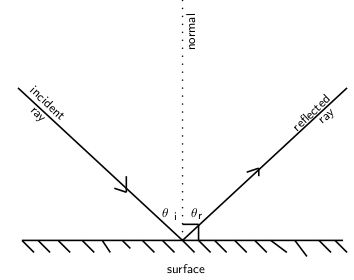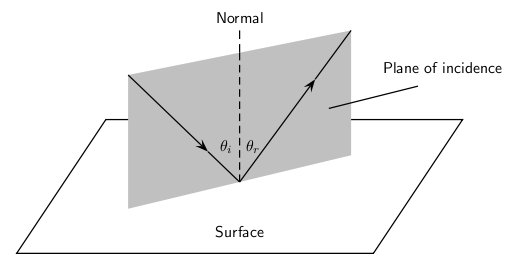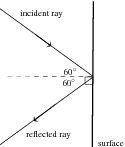| << Chapter < Page | Chapter >> Page > |
When you smile into a mirror, you see your own face smiling back at you. This is caused by the reflection of light rays on the mirror. Reflection occurs when a light ray bounces off a surface.
In Transverse Pulses and Transverse Waves we saw that when a pulse or wave strikes a surface it is reflected . This means that waves bounce off things. Sound waves bounce off walls, light waves bounce off mirrors, radar waves bounce off aeroplanes and it can explain how bats can fly at night and avoid things as thin as telephone wires. The phenomenon of reflection is a very important and useful one.
We will use the following terminology. The incoming light ray is called the incident ray . The light ray moving away from the surface is the reflected ray . The most important characteristic of these rays is their angles in relation to the reflecting surface. These angles are measured with respect to the normal of the surface. The normal is an imaginary line perpendicular to the surface. The angle of incidence, is measured between the incident ray and the surface normal. The angle of reflection, is measured between the reflected ray and the surface normal. This is shown in [link] .
When a ray of light is reflected, the reflected ray lies in the same plane as the incident ray and the normal. This plane is called the plane of incidence and is shown in [link] .


The Law of Reflection states that the angles of incidence and reflection are always equal and that the reflected ray always lies in the plane of incidence.
The Law of Reflection states that the angle of incidence is equal to the angle of reflection.
The simplest example of the law of incidence is if the angle of incidence is . In this case, the angle of reflection is also . You see this when you look straight into a mirror.

If the angle of incidence is not , then the angle of reflection is also not . For example, if a light strikes a surface at to the surface normal, then the angle that the reflected ray makes with the surface normal is also as shown in [link] .

An incident ray strikes a smooth reflective surface at an angle of 33 to the surface normal. Calculate the angle of reflection.
We are given the angle between the incident ray and the surface normal. This is the angle of incidence.
We are required to calculate the angle of reflection.
We can use the Law of Reflection, which states that the angle of incidence is equal to the angle of reflection.
We are given the angle of incidence to be 33 . Therefore, the angle of reflection is also 33 .

Notification Switch
Would you like to follow the 'Siyavula textbooks: grade 10 physical science' conversation and receive update notifications?